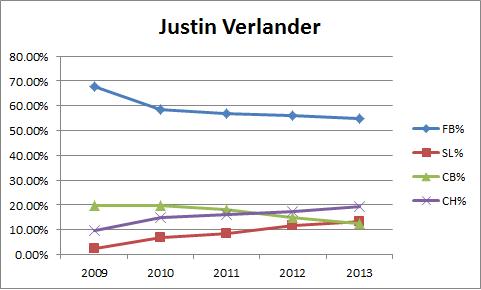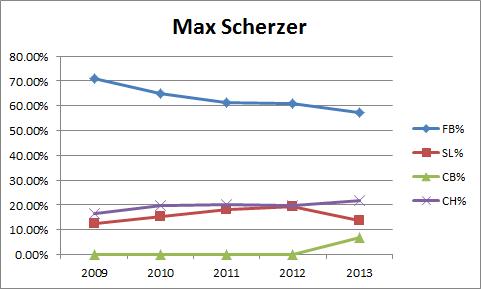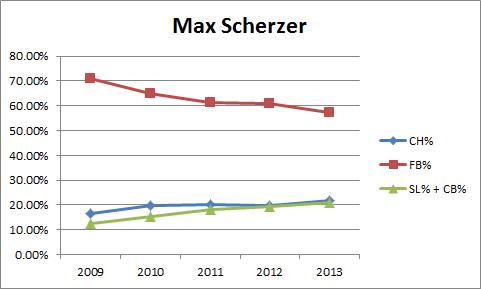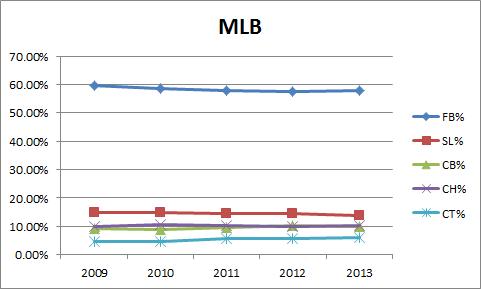Fastball velocity catches your attention. Knee-buckling breaking balls demand respect. But the changeup is not usually a pitch that grabs headlines, but here I am, writing about it. I’ve mentioned it briefly in these electronic pages and Rod Allen has touched on it as well: the Tigers are throwing more changeups and it’s working.
Now I’m not sure if this change is coming from Jeff Jones, the Tigers pitching coach, or Jim Leyland. Maybe it’s coming from Alex Avila. Perhaps the starters are doing it themselves and learning from one another. Heck, the front office could be putting useful information about the pitch in front of the players. I don’t know the answer, but I know it’s happening and I know it’s yielding some good results.
First, let’s check out the Tigers starting pitching as a whole over the last five seasons:
The trend is pretty clear, even if we can’t identify the cause. The Tigers are trading fastballs and sliders for curveballs and changeups. Now the slider versus curveball transformation could be many things, but those are both breaking balls and they are moving together. The changeup is a distinct pitch. Let’s look at the same chart but with sliders and curveballs combined:
This allows you to see the trend a little better. Fastballs down, changeups up. Breaking balls mostly constant (splitters, cutters, knucklers all excluded due to very low numbers).
So is this an overall trend that reflects a difference in organizational approach, or is one pitcher getting changeup happy and obscuring the results. (The size of the scale on the vertical axis makes these changes look minor, but we are talking about noticeable changes).
Justin Verlander
Verlander, as you can see below, matches the overall trend perfectly. He’s changed the breaking ball he throws, but he hasn’t really changed the percentage of breaking balls. He has, however, traded fastballs for changeups:
Max Scherzer
The pattern fits Scherzer (joined the Tigers in 2010) a bit less cleanly, as he is using more breaking balls and changeups instead of the fastball. You can see here:
Rick Porcello
I’ve made a ton of Rick Porcello’s breakout campaign this season, and looking at his pitch type, he fits the mold perfectly:
Doug Fister
Fister, too, fits the mold especially if you look at his change from 2011 (when he joined the Tigers):
Anibal Sanchez
Sanchez also fits the mold, especially since joining the Tigers last year, but he is trading breaking balls for changeups more so than fastballs in recent years:
Twelve graphs later, what have we learned? Well we can see that the Tigers starters are collectively and individually moving toward changeups at the expense of the fastball, while also shifting which types of breaking balls they throw. I’m not sure if this change in approach is coming from the pitching coach, the catcher, or the pitchers themselves, but the trend exists and it’s hard to argue with the staff that has 4 of the top 12 pitchers by WAR so far in 2013 and leads the league by more than 3 full wins as an entire pitching staff.
You can see how the results are getting better, even if not all five guys were on the staff each year. Compare this to the top charts. I’m not making the case that the changeups are making the Tigers staff this much better, but rather that the change in pitch type as an organization is a noticeable trend that is tracking with success:
And the last question you should be asking, also has an answer. This is not a league-wide trend:
The Tigers are throwing more changeups. I’m not sure whose idea it was, but it’s working and it isn’t happening in all 30 major league cities. Changeups aren’t usually thought about as a “stuff” pitch, but it might be time to rethink that approach. I know there are some advocates for the pitch, like Dave Cameron at Fangraphs, who like me, thinks great changeups are vastly underappreciated, but on the whole, we overlook the changeup. Maybe we shouldn’t.















[…] top 8 pitchers in MLB by WAR and 4 of the top 6 in the AL. Also of interest to Tigers fans might be yesterday’s post on the team’s increase use of the changeup over the last few […]
[…] this season, I wrote about how the Tigers starters were utilizing the changeup more often this season and that it was working to their advantage. Yesterday, I took on Rick […]
[…] written before about how the Tigers as a team are throwing more changeups and how Scherzer, Porcello, and Sanchez have all made leaps into the upper echelons of MLB […]
[…] out New English D on Porcello’s Breakout Campaign, Anibal Sanchez’s Cy Young Leap, The Tigers Approach to Pitching, and Why They Have the Best Rotation […]
[…] going to the changeup instead of the curveball more often, just like so many Tigers pitchers, and it’s becoming a better pitch for him. He’s throwing the changeup more and […]
[…] at with Fister is another member of the Detroit School of Pitching. I looked at the team trends here, and how it’s working for Porcello (above), Sanchez, and Scherzer so far. Jeff Jones or […]
[…] It’s also time for him to come under the tutelage of Jeff Jones, who might be some type of changeup and/or strikeout savant. (Also, this, this, and […]
[…] Sanchez who really caught my eye during the 2013 campaign. He made excellent use of his changeup (as did all of the Tigers pitchers this year) and dramatically improved his strikeout and homerun numbers in 2013 while posting career bests in […]
[…] of my favorite New English D pieces last year pointed out how the Tigers seemed to be increasing their use of the changeup rotation wide. It wasn’t clear if the changeup directive was coming from the front office, […]
[…] The problem is not small, as Porcello’s change was a huge part of his success dating from the great Detroit changeup renaissance in 2013 up through much of 2014. In the first half of 2014, opponents slugged under .200 against […]